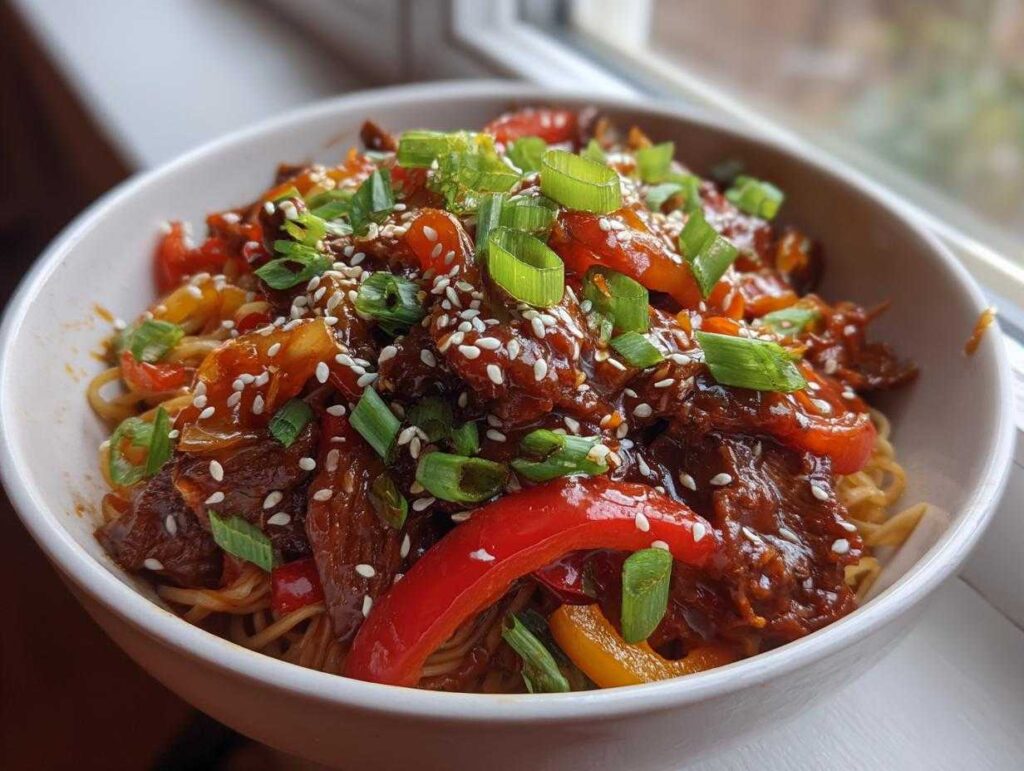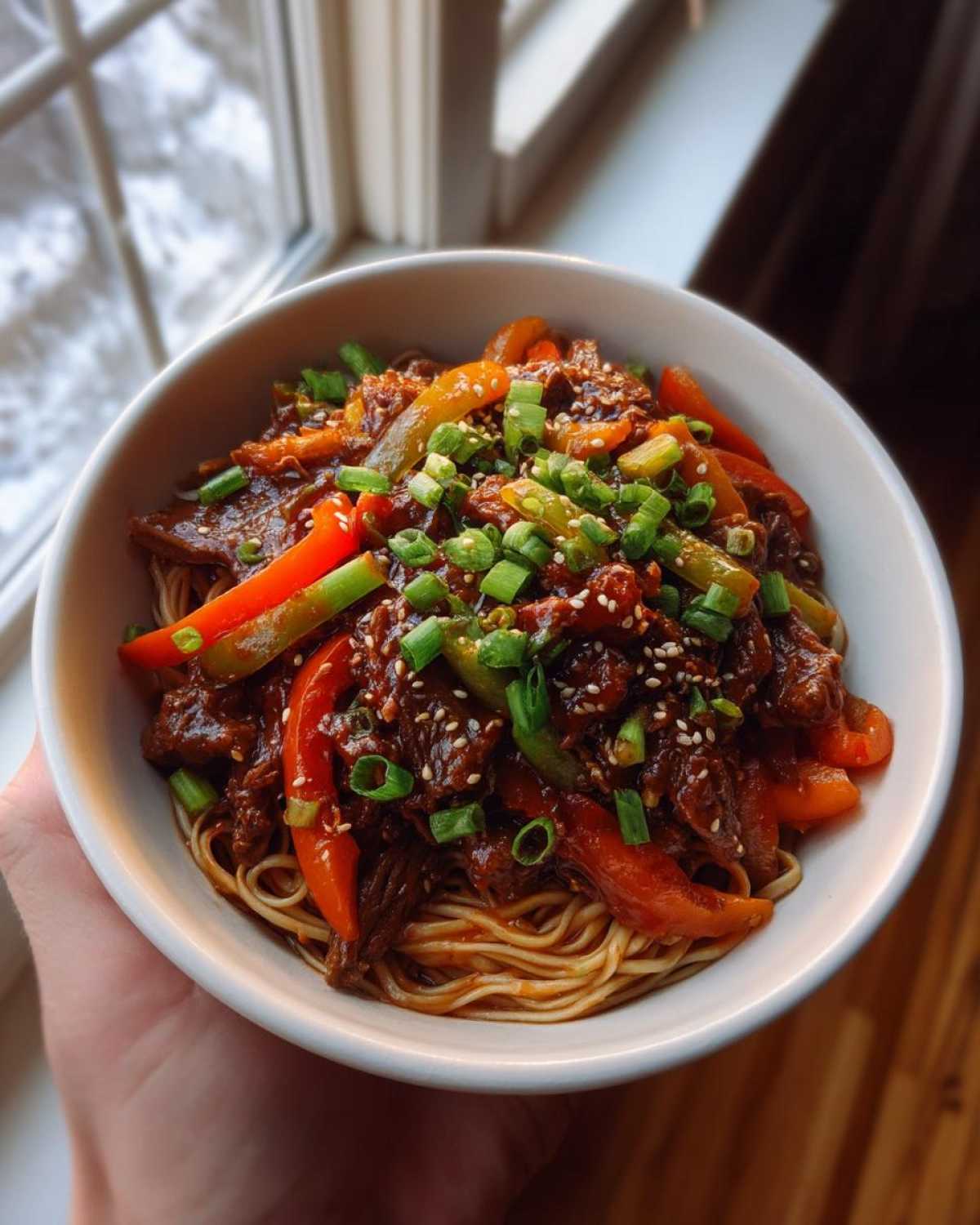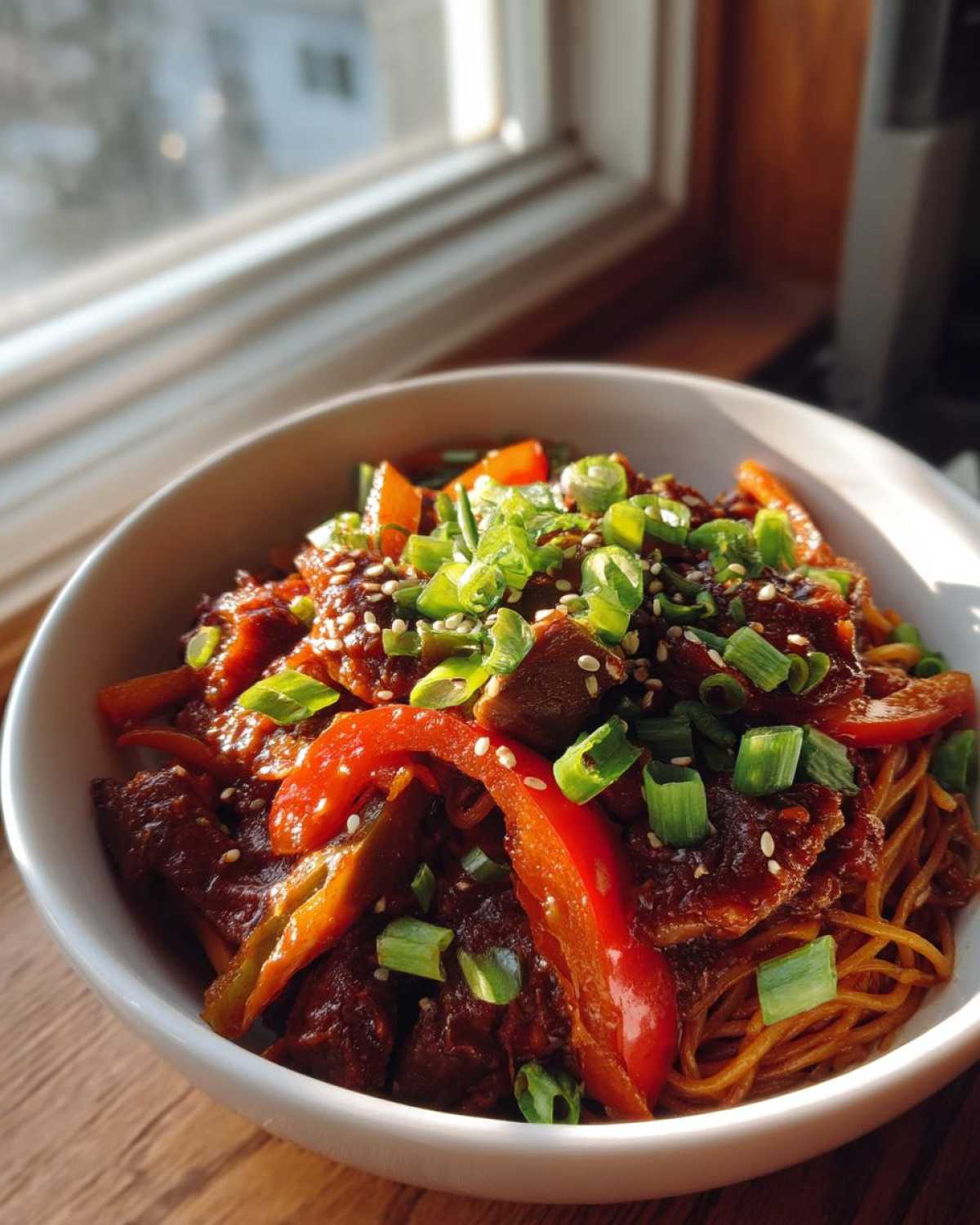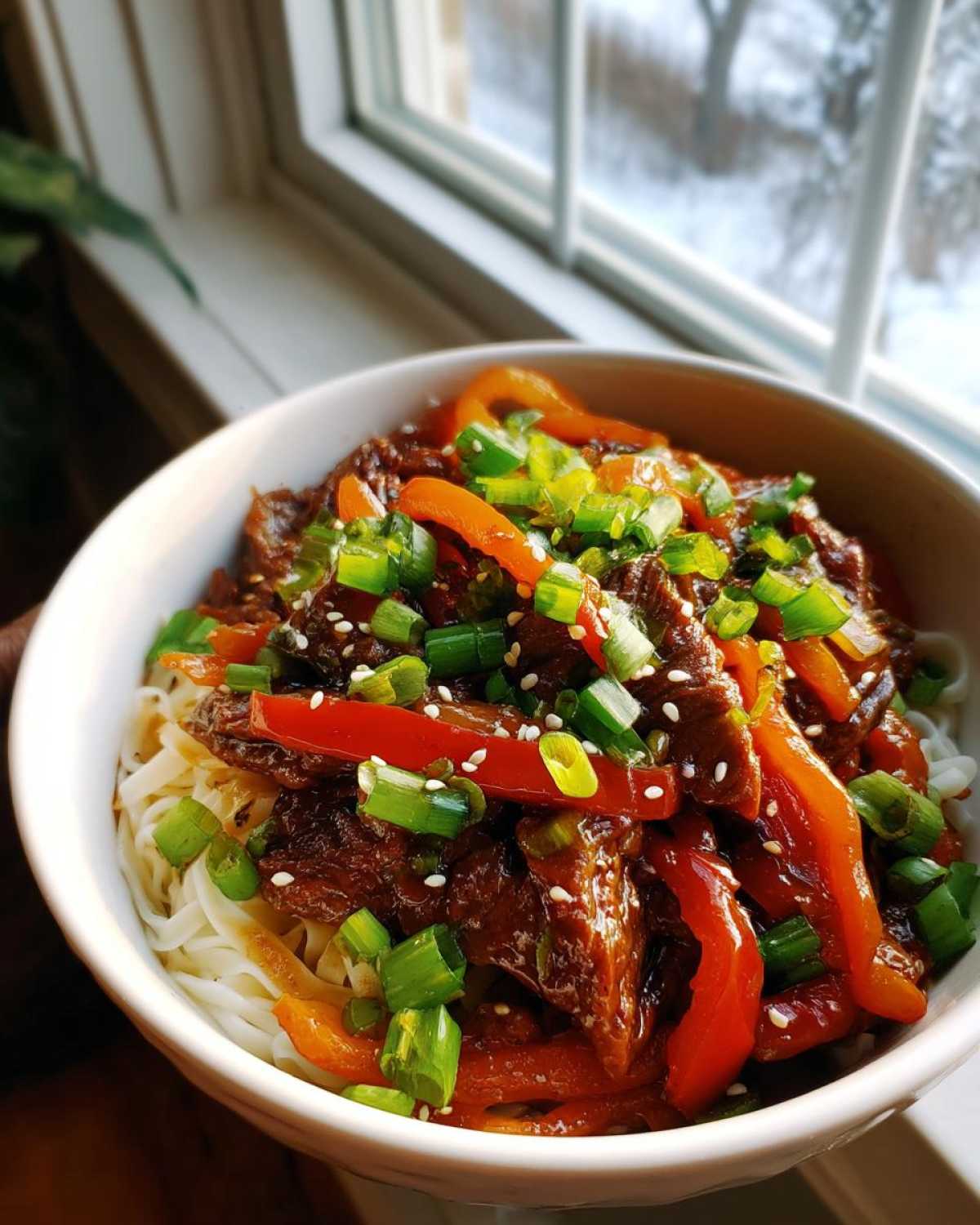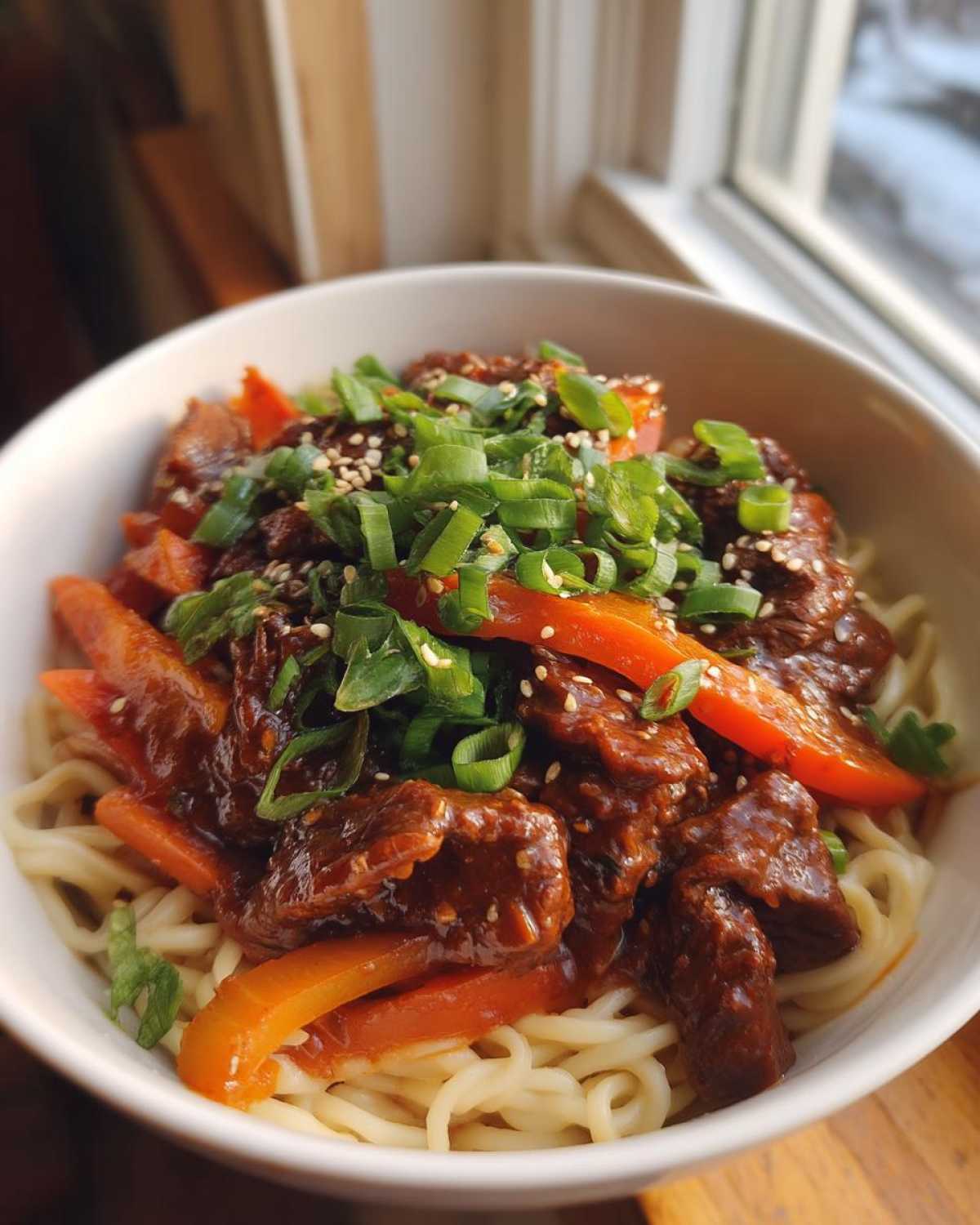I still remember my first bite of real Korean food – a steaming bowl of spicy, savory goodness that made my taste buds dance. It was love at first slurp! That’s when I knew I had to recreate that magic at home. These Spicy Korean Gochujang Beef Noodles are my weeknight hero – ready in under 30 minutes but packed with so much flavor you’d think it simmered all day. The secret? That glorious gochujang paste that gives the dish its signature kick and deep, complex flavor. Trust me, once you try this recipe, you’ll be making it on repeat!
- Why You’ll Love These Spicy Korean Gochujang Beef Noodles
- Ingredients for Spicy Korean Gochujang Beef Noodles
- How to Make Spicy Korean Gochujang Beef Noodles
- Serving Suggestions for Spicy Korean Gochujang Beef Noodles
- Storage & Reheating
- Spicy Korean Gochujang Beef Noodles FAQs
- Nutritional Information
Why You’ll Love These Spicy Korean Gochujang Beef Noodles
This dish is my go-to when I need something fast, flavorful, and downright addictive. Here’s why it’ll become your new favorite too:
- Bold flavors that wow – That sweet-spicy gochujang sauce clings to every noodle and piece of beef like a flavor bomb
- Faster than takeout – Ready in just 25 minutes from fridge to table (I’ve timed it during my hungriest moments!)
- Endlessly adaptable – Swap in chicken, tofu, or whatever veggies you’ve got hanging around
- Meal prep superstar – The flavors get even better overnight (if you can resist eating it all at once)
Ingredients for Spicy Korean Gochujang Beef Noodles
Here’s everything you’ll need to make this flavor-packed dish. I like to prep everything before I start cooking – trust me, it makes the process so much smoother when you’re in the middle of stir-frying!
- 8 oz beef sirloin – thinly sliced against the grain (this keeps it tender)
- 4 oz rice noodles – the flat kind works best for clinging to sauce
- 2 tbsp gochujang paste – the star ingredient! (more on this below)
- 1 tbsp soy sauce – I use regular but low-sodium works too
- 1 tbsp honey – balances the heat beautifully
- 1 tbsp sesame oil – that nutty aroma is everything
- 2 cloves garlic – minced (fresh is best, but 1/2 tsp powder works in a pinch)
- 1 tsp ginger – freshly grated makes all the difference
- 1/2 cup bell peppers – sliced thin (I use red for color but any work)
- 1/2 cup carrots – julienned (those matchstick cuts soak up sauce perfectly)
- 2 green onions – chopped, plus extra for garnish
- 1 tbsp sesame seeds – for that final crunchy touch
Ingredient Notes & Substitutions
Gochujang is that magical Korean chili paste – start with 2 tbsp and add more if you like it fiery! For milder heat, mix in some extra honey. Vegetarian? Swap beef for firm tofu or mushrooms. Gluten-free friends can use tamari instead of soy sauce. The veggies are flexible too – zucchini or snap peas work great when I’m cleaning out my fridge!
How to Make Spicy Korean Gochujang Beef Noodles
Okay, let’s get cooking! I promise this comes together faster than you can say “seconds please.” Just follow these simple steps and you’ll have restaurant-quality noodles in no time.
1. Cook the noodles just right
First things first – get those rice noodles going. Follow the package instructions, but here’s my trick: cook them 1 minute less than suggested for perfect al dente texture. They’ll finish cooking in the sauce later. Drain them and toss with a tiny bit of oil to prevent sticking while you prep everything else.
2. Make that killer sauce
Grab a small bowl and whisk together your gochujang, soy sauce, honey, sesame oil, garlic, and ginger. Taste it! Want more heat? Add another teaspoon of gochujang. Too spicy? A squeeze more honey balances it out. This sauce is your flavor foundation, so adjust it to your taste.
3. Sear the beef to perfection
Heat a large pan or wok over medium-high heat – you want it nice and hot. Add your thinly sliced beef in a single layer (don’t crowd the pan!) and let it sear undisturbed for about 1 minute per side. We’re going for golden brown edges here, not gray boiled meat. Remove the beef and set aside – it’ll finish cooking later.
4. Stir-fry the veggies
In that same hot pan (all those beefy flavors are gold!), toss in your bell peppers and carrots. Stir-fry for just 2-3 minutes until they’re bright and slightly tender but still have crunch. Overcooked veggies = sad noodles.
5. Bring it all together
Now the magic happens! Return the beef to the pan and pour in your sauce. Stir everything until it’s beautifully coated – the sauce should cling to every ingredient like a flavor hug. Add your cooked noodles and gently toss until everything’s combined and heated through. The noodles will soak up that amazing sauce as they finish cooking.
6. The finishing touches
Kill the heat and sprinkle with green onions and sesame seeds. I always add an extra drizzle of sesame oil at the end because… well, because it’s delicious. Serve immediately while it’s piping hot!
Pro Tips for Perfect Spicy Korean Gochujang Beef Noodles
- Prep is key – Have all ingredients chopped and measured before you start cooking. Stir-fries move fast!
- Control the heat – If your pan starts smoking, lower the temp slightly. Burnt garlic = bitter noodles.
- Noodle know-how – Rinse cooked rice noodles with cold water to stop cooking if you’re not using them right away.
- Leftover magic – The flavors deepen overnight! Store leftovers in an airtight container and reheat gently with a splash of water to loosen the sauce.
Serving Suggestions for Spicy Korean Gochujang Beef Noodles
Now for my favorite part – making this dish a complete meal! These noodles are fantastic on their own, but a few simple sides can take them to the next level. Here’s how I love to serve them:
Kimchi is a must – that tangy, fermented crunch cuts through the richness perfectly. I keep a jar of homemade kimchi in my fridge just for this dish (though store-bought works great too). The spicy cabbage adds another layer of flavor that makes each bite exciting.
For something cooling, try a quick cucumber salad – just slice cucumbers thin and toss with rice vinegar, a pinch of sugar, and sesame seeds. It’s like a refreshing palate cleanser between spicy bites. My grandma always said the contrast makes both dishes taste better, and she was absolutely right.
Want to make it a feast? Add some Korean-style spinach (sigeumchi namul) – blanched spinach with garlic and sesame oil. Or keep it simple with steamed edamame sprinkled with sea salt. Both add nice texture and balance to the meal.
Don’t forget the garnishes! I always put out extra sesame seeds, sliced green onions, and sometimes toasted nori strips for topping. Let everyone customize their bowl – it makes dinner more fun! A squeeze of lime adds brightness if you’re feeling fancy.
Pro tip: Serve with extra gochujang sauce on the side for spice lovers. My brother always drizzles more on his portion – though I warn you, it’s not for the faint of heart!
Storage & Reheating
Here’s the good news – these noodles taste even better the next day as the flavors really settle in! But you’ve got to store and reheat them right to keep that perfect texture. I learned this the hard way after a few sad, mushy noodle experiences.
Fridge storage: Let the noodles cool completely (but don’t leave them out more than 2 hours). Transfer to an airtight container – I like to use glass so the sauce doesn’t absorb any plastic flavors. They’ll keep beautifully for 3-4 days in the fridge. The sauce might thicken up, but that’s an easy fix when reheating.
Freezer option: You can freeze these for up to 2 months, though the noodles might soften a bit. Portion them out first – I use freezer bags laid flat so they stack easily. Thaw overnight in the fridge before reheating.
Reheating like a pro: Skip the microwave if you can! Instead, warm them gently in a skillet with a splash of water or broth over medium-low heat. Stir frequently until heated through – this keeps the noodles from getting gummy. If you must microwave, do it in 30-second bursts with a damp paper towel over the top, stirring between each.
Little tip from my kitchen disasters: If the noodles seem dry after storage, a quick drizzle of sesame oil or a teaspoon of water mixed in while reheating brings them right back to life!
Spicy Korean Gochujang Beef Noodles FAQs
I get so many questions about this recipe – which means you all love it as much as I do! Here are the answers to everything you might wonder about these addictive noodles:
Can I use chicken instead of beef?
Absolutely! Thinly sliced chicken thighs work beautifully here – they stay juicy even with the quick cooking. Just increase the cook time by about 1-2 minutes since chicken needs to be fully cooked through. I’ve even made this with shrimp when I’m feeling fancy!
How can I make it less spicy?
No shame in dialing back the heat! Start with just 1 tablespoon of gochujang instead of 2, and add more to taste. Extra honey or a splash of rice vinegar helps balance the spice too. My mom adds a tablespoon of peanut butter to the sauce when she wants it milder – sounds weird but it works!
What if I can’t find gochujang?
In a pinch, mix 1 tbsp sriracha with 1 tbsp miso paste and 1/2 tsp sugar. It won’t be exactly the same, but it’ll give you that sweet-spicy-umami vibe. Though trust me – once you try real gochujang, you’ll want to keep a tub in your fridge forever!
Can I make this vegetarian?
Yes! Swap the beef for extra-firm tofu (press it first!), mushrooms, or even chickpeas. Use vegetable broth instead of beef broth if your sauce needs thinning. The sauce is so flavorful that you won’t miss the meat at all.
Why do my noodles stick together?
Ah, the great noodle struggle! Make sure to rinse them well after cooking and toss with a bit of oil. If they still clump, try soaking them in warm water instead of boiling – just takes a few minutes longer. And always add them to the pan last so they don’t overcook and get gummy.
Nutritional Information
Now, I’m no nutritionist, but I do like knowing what’s going into my body – especially when it tastes this good! Here’s the scoop on what you’re getting in each serving of these Spicy Korean Gochujang Beef Noodles (based on the exact ingredients I use):
- Calories: About 450 per generous serving
- Protein: 25g (that beef really delivers!)
- Carbs: 55g (mostly from those satisfying rice noodles)
- Fiber: 4g (thanks to all those crunchy veggies)
- Sugar: 12g (the honey and gochujang add natural sweetness)
- Fat: 15g (the good kind from sesame oil and beef)
Remember, these numbers are estimates – your exact nutrition will depend on your specific ingredients and portion sizes. I’ve found the sodium can vary a lot based on your soy sauce brand, so if you’re watching that, definitely go for low-sodium options.
The best part? This dish packs serious flavor without loading up on empty calories. You’re getting quality protein, colorful veggies, and that amazing fermented goodness from the gochujang. It’s a meal that satisfies your taste buds and fuels your body – my favorite kind of cooking!
Try this recipe tonight and tag us with your creation! I love seeing your spicy noodle masterpieces – it makes my day to know you’re enjoying this dish as much as I do.
Print30-Minute Spicy Korean Gochujang Beef Noodles That Will Blow Your Mind
Spicy Korean Gochujang Beef Noodles are a flavorful and easy-to-make dish that combines tender beef with a spicy, savory sauce. Perfect for a quick weeknight dinner or a weekend feast.
- Prep Time: 10 mins
- Cook Time: 15 mins
- Total Time: 25 mins
- Yield: 2 servings 1x
- Category: Main Course
- Method: Stir-fry
- Cuisine: Korean
- Diet: Low Lactose
Ingredients
- 8 oz beef sirloin, thinly sliced
- 4 oz rice noodles
- 2 tbsp gochujang paste
- 1 tbsp soy sauce
- 1 tbsp honey
- 1 tbsp sesame oil
- 2 cloves garlic, minced
- 1 tsp ginger, grated
- 1/2 cup bell peppers, sliced
- 1/2 cup carrots, julienned
- 2 green onions, chopped
- 1 tbsp sesame seeds
Instructions
- Cook rice noodles according to package instructions. Drain and set aside.
- In a bowl, mix gochujang, soy sauce, honey, sesame oil, garlic, and ginger.
- Heat a pan over medium-high heat. Add beef and cook until browned.
- Add bell peppers and carrots. Stir-fry for 2-3 minutes.
- Pour the sauce over the beef and vegetables. Stir to coat evenly.
- Add cooked noodles and toss to combine.
- Garnish with green onions and sesame seeds before serving.
Notes
- Adjust gochujang for more or less spice.
- Substitute chicken or tofu for beef if preferred.
- Serve with a side of kimchi for extra flavor.
Nutrition
- Serving Size: 1 serving
- Calories: 450
- Sugar: 12g
- Sodium: 800mg
- Fat: 15g
- Saturated Fat: 4g
- Unsaturated Fat: 8g
- Trans Fat: 0g
- Carbohydrates: 55g
- Fiber: 4g
- Protein: 25g
- Cholesterol: 60mg

